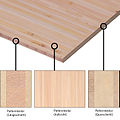Texture (computer graphics)
In computer graphics , textures are used as “coatings” for 3D models, in order to increase their level of detail without, however, increasing the level of detail of the geometry.
A texture is an image that is displayed on the surface of a virtual body . This mapping is about texture mapping . One pixel of the texture is called a “texel”.
Together with a so-called shader , which can map material properties, textures can change practically every property of a surface in a targeted manner, for example the color, surface normals, “roughness” and others.
The advantage of using textures over using a more detailed model is that the display is often faster and storage space can be saved. The disadvantage is that textures only change the visual appearance, but not the geometry (exception: displacement maps ).
In the level design so-called pattern textures are used. These are tileable textures, meaning they can be attached to each other seamlessly. For example, walls with the same texture can be pushed against each other realistically without a noticeable transition.
Examples
See also
- Image synthesis
- Texture compression
- Bump mapping
- Displacement mapping
- Normal mapping
- Mip mapping
- Skin (computer games)




